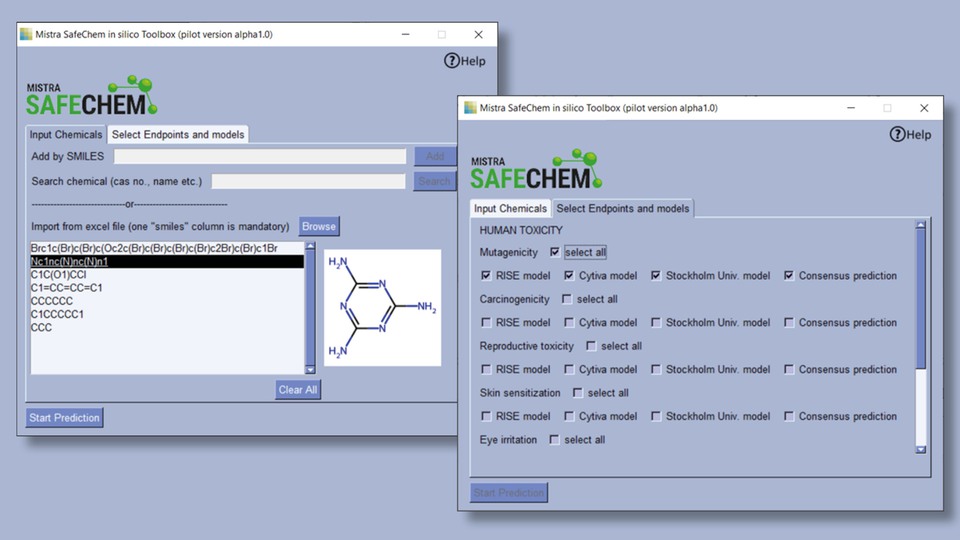
Graphical user interface of the software (pilot version, might be changed in the formal version).
A high-quality prediction computer tool is developed within Mistra SafeChem
Mistra SafeChem researchers Ulf Norinder, Swapnil Chavan and Ziye Zheng have developed three sets of computational models which can identify hazardous compounds.
In 2021, a news article External link. from the Mistra SafeChem programme described the ambition to build a high-quality prediction in silico tool for identifying compounds that may have hazardous properties, e.g. toxicity, persistence, endocrine activity, and organ toxicity.
External link. from the Mistra SafeChem programme described the ambition to build a high-quality prediction in silico tool for identifying compounds that may have hazardous properties, e.g. toxicity, persistence, endocrine activity, and organ toxicity.
Another news article External link., published this year, described the development of a similar tool more specifically tailored for the Cytiva corporation.
External link., published this year, described the development of a similar tool more specifically tailored for the Cytiva corporation.
Both these efforts contribute to the ambition of building a high-quality prediction computer tool.
Started with one set of models
In early 2021 only one set of models primarily existed for all of the application areas including targets such as endocrine (hormone) disruptors, carcinogenicity, mutagenicity as well as biodegradability.
These models were developed using traditional machine learning and chemical compound characterization (descriptor) methods such as Random Forest and physicochemical descriptors, respectively.
Deep Learning methods are used
Today three sets of models exist, developed within Mistra SafeChem by Swapnil Chavan, Unit of Chemical and Pharmaceutical Toxicology at RISE, Ulf Norinder, Dept of Computer and Systems Sciences at Stockholm University, and Ziye Zheng, Cytiva.
These models span both the traditional machine learning methods and state-of-the-art methods from the rapidly developing artificial intelligence field called Deep Learning. In addition, they contain procedures for defining the uncertainty associated with each prediction, making them more useful for decision-making by the end-users.
A new graphical user interface
– To integrate the prediction outcomes from all three types of models into an overarching decision along with estimated uncertainty in those predictions, we have developed a standalone graphical user interface application, Ulf Norinder explains.
The constructed software will be disseminated to all Mistra SafeChem partners along with a guidance document. Workshops will also be held to train and educate users of this software.
More to read in scientific journals
Read more about investigations related to the models in these scientific articles:
- Predicting Endocrine Disruption Using Conformal Prediction – A Prioritization Strategy to Identify Hazardous Chemicals with Confidence
 External link, opens in new window.
External link, opens in new window. - In silico identification of potential thyroid hormone system disruptors among chemicals in human serum and chemicals with a high exposure index
 External link, opens in new window.
External link, opens in new window. - Traditional Machine and Deep Learning for Predicting Toxicity Endpoints
 External link, opens in new window.
External link, opens in new window. - In Silico Prediction of Eye Irritation Using Hansen Solubility Parameters and Predicted pKa Values
 External link, opens in new window.
External link, opens in new window. - hERG-toxicity prediction using traditional machine learning and advanced deep learning techniques
 External link, opens in new window.
External link, opens in new window.
-
2024-06-28 | newsImpressive achievements of Mistra SafeChem in phase 1
-
2024-06-19 | newsNew report: Crystal Engineering for Water Treatment
-
2024-05-17 | newsSee the full agenda for our final webinar
-
2024-05-15 | newsThe Mistra SafeChem in silico toolbox presented at the SETAC conference
-
2024-04-03 | newsFour more years – Mistra SafeChem gets go-ahead for second phase
